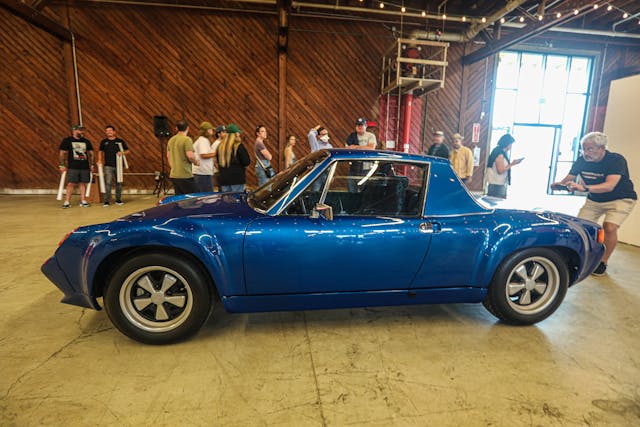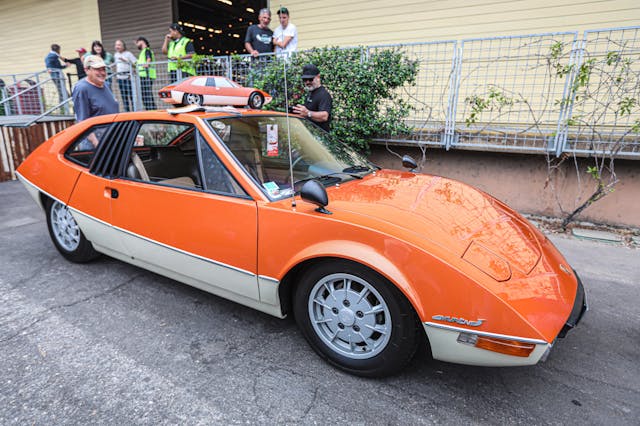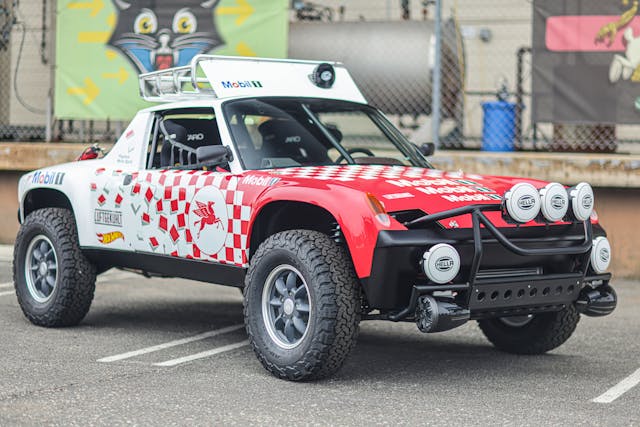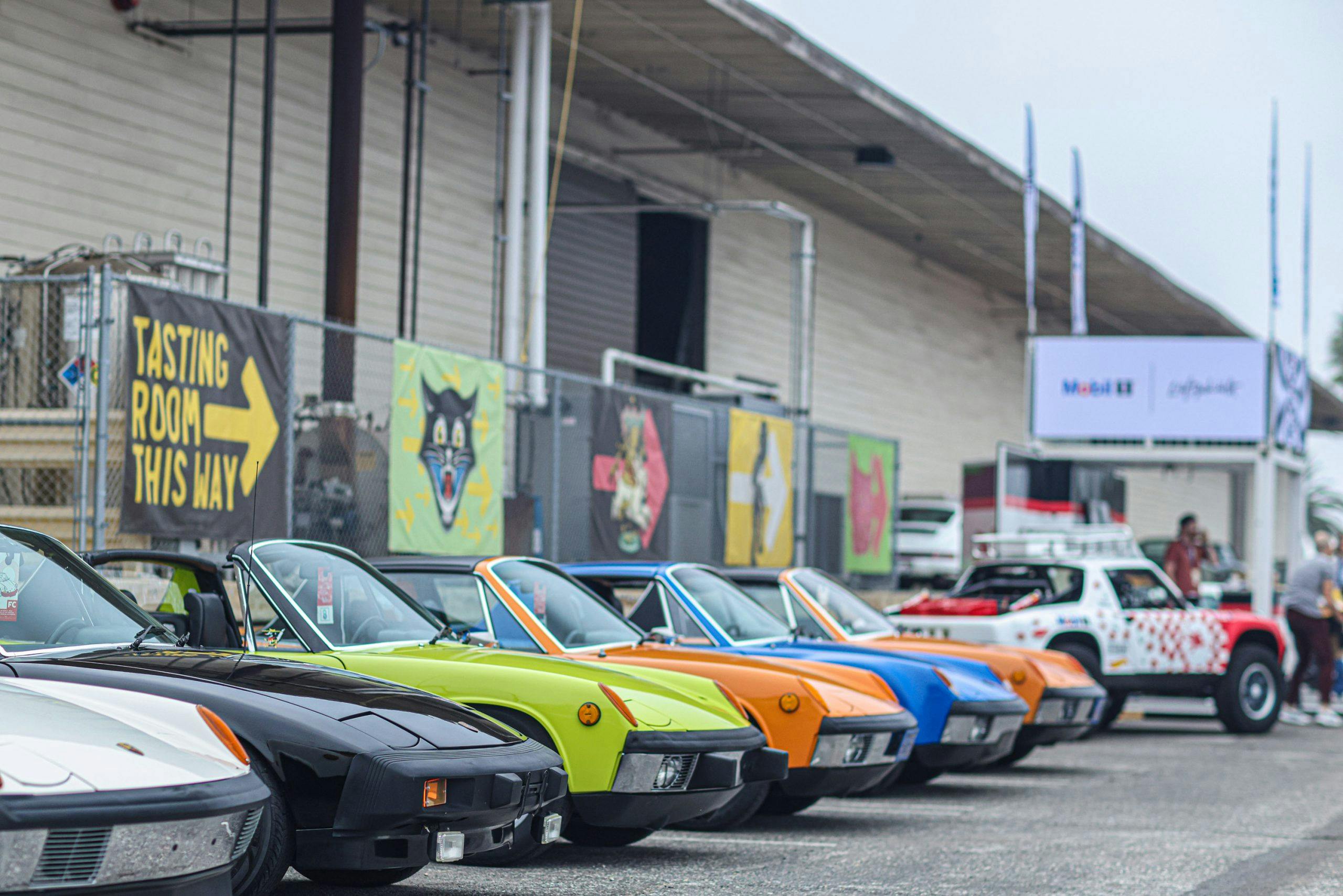Media | Articles
914s made the case for mid-engine at Luftgekühlt 8
The 911 is Porsche’s most iconic sports car, and as we laid out in yesterday’s article, Luftgekühlt is the marque’s coolest show. So, it stands to reason that the sweetest P-car fruit at this past weekend’s Luft 8 fell from the neunelfer family tree. We reckon that’s probably the case, as it’s tough to concentrate and easy to wander when faced with a field of candy-colored Carreras. But, Luft 8’s most interesting Porsches? That fell to the eclectic array of the off-beat Porsche 914.
This might surprise the folks behind Luft. 2019’s Luft 6 was the place to be for special 914s, and last year’s Luft 7 in Indianapolis featured several noteworthy iterations of the mid-engine Porsche. For Luft 8, they filled an ex-Navy ship-building warehouse in the Port of Los Angeles with a brain-blending potpourri of early RSes and early Porsche racing prototypes, complemented by enough noteworthy 356s to stock a museum. A 914 is to many the least interesting air-cooled Porsche at a show, but this crop felt different.
But we’ve seen Carrera 2.7 RSes before, as we have 993 GT2s and 964 Cups. What we have not seen in person is a Porsche 916, one of just 11 cars built in 1972. Developed as part of an exploratory program on the outer performance limits of the production platform of the 914, the 916 was to pick up where the 914/6 left off.
From a detail-oriented perspective, Luft is a difficult show to cover, as none of the cars are parked with placards or signage of any type. So, our info on this specific royal blue 916 is speculative at best; depending on development date, engineers fitted each prototype 916 with either a 2.4- or 2.7-liter flat-six from the contemporary 911. Power ranged from 190 hp for the smaller mill to a contemporaneously gutsy 210 hp for the bigg’un.
This was ostensibly Porsche’s play at Ferrari’s Dino 246. Steel flairs and a welded steel roof—as opposed to the standard 914’s targa top—keyed up the visual aggression, as did fiberglass fascias from the 914-6 GT. The design department went buck wild on these mules, sloshing on experimental paint colors and working with previously unused interior materials. The windows were up on Luft’s 916, otherwise we’d showcase the psychedelic paisley upholstery.
Marketplace
Buy and sell classics with confidence
It was darn quick, too. The 916 clipped 165 pounds off the 911 S’ curb weight, and its sub-seven-second 0-60 mph scramble made it the quickest production Porsche of its day—that’s if it ever made it past the prototype stage. Porsche claims pushing the 916 to production was too expensive, but popular theory points to the automaker’s eternal reluctance to put any junior sportscar ahead of the 911’s envelope.
On the road, at least. As one of 16 competition-grade GTs built in 1970, the AlphaLuxe Collection’s Porsche 914/6 GT is sharper than even the contemporary Carrera RS 2.7. A 914/6 GT—more specifically, the white GT that was on display at Luft 8 inside the main display area—took sixth at the 1970 24 Hours of Le Mans, bested only by 917s, a 908, and a pair of Ferrari 512S. Crucially, this meant a field of seven 911s trailed behind that works GT, setting a precedent for Porsche’s relatively under-appreciated and slow-selling 914/6.
This Le Mans success didn’t do much for GT sales. A 914/6 GT from Porsche’s Werks 1 customer racing division cost just about as much as a race-ready 911 2.5, and most customers sprang for that quicker, more competitive car. This GT is a great representation of the breed, wearing the signature Signal Orange paint.
Orange is a great color on 914s—even when a 914 isn’t a 914. The whacky 1970 914-6 “Murene” prototype was certainly the most striking car in attendance, even parked in proximity to a Viper Green 964 and a pair of 993 Carrera RS. This is French designer Jacques Cooper’s vision of what the 914 should have been; following the 914/6’s production debut, Cooper convinced industrial design firm and his employer Brissonneau et Lotz to re-body the nascent sports car as part of a design competition commissioned by Porsche itself.
An early production 914/6 was acquired, and work began. Financial troubles stymied progress, and a deal was struck with Heuliez—another French design house—to wrap up the project. The only bits carried over from the standard 914 were the door handles, pop-up headlights, powertrain, and that snazzy Porsche crest up on the snout.
The so-called Murene dropped cover at the 1970 Paris show in an era-appropriate metallic brown over beige color scheme, with a later showing at that year’s Geneva auto show. It was all for naught; Porsche abandoned plans for a mid-engine layout for the 914’s successor, rendering all contest entrants null. The Murene remained in Heuliez’ archive until its dissolution in 2012, when it entered private ownership in France. It was sold again earlier this year on PCarMarket, apparently making landfall in the U.S.
It’s the weirdest 914, but not the wildest. That honor goes to Kevin Jeannette’s safari’d 914 that’s made the rounds through last year’s SEMA show and this year’s Hot Wheels Legends Tour, now settling in at Luft 8 as part of Mobil 1’s display booth. This is a collaboration between Gunnar Racing, Mobil 1, Luftgekühlt, and Hot Wheels to bring a 1:64 scale design to life. Details are scant on just how much 914 remains under the fiberglass shell, but there’s no mistaking that profile and the six-cylinders under the rear decklid.
Check out the Hagerty Media homepage so you don’t miss a single story, or better yet, bookmark it.












The term mid-engine has always amused me. With some exceptions, there are only two positions for the engine… in front of the driver (a.k.a. front), and behind the driver (a.k.a. rear). There are some exceptions with 60s vans and at least one 90s era Mitsubishi minivan where the engine dwells in the same vicinity as the driver that I would call valid mid-engine vehicles. Calling a rear-engined vehicle a mid-engine vehicle is kind of like calling the game played with a soccer ball football
Mid engine is really well defined as behind the front axle or in front of the rear axle.
The one true mid engine car that most will recall is the Cheetah. The engine was right in the center of the chassis and the driver was fitted in behind engine nearly on the rear axle.
The real key to all this is get the weight as close to center and low to not have polar movement in the chassis.
You can still be 50/50 but more centered the weight the better. These principals even existed in the Soapbox Derby car we built.
The car coming down the hill was much like a race car in a corner. Keeping the weight in the center and low made the chassis more efficient and not lose speed.
It kept the weight even on all 4 wheels. But we would do a bit of tuning by adding just a little weight to the rear. More weight higher on the hill had to travel down hill more giving a boost off the hill.
The physics of all this is pretty simple once you get the hang of it. Then you look for ways to use it.
The 914 is seeing some interest I believe due to the increase of the 911 prices getting crazy.
People want the simplicity of the air cooled cars but not all want to pay the 911 premium anymore as even the cheapest clean cars are $50k.
The 944 and 924 appeal to a different set of fans. Many air cooled guys don’t even consider the VW based cars Porsches. But that is an argument for another time and place.
People will now start digging out these cars looking for clean chassis to restore.